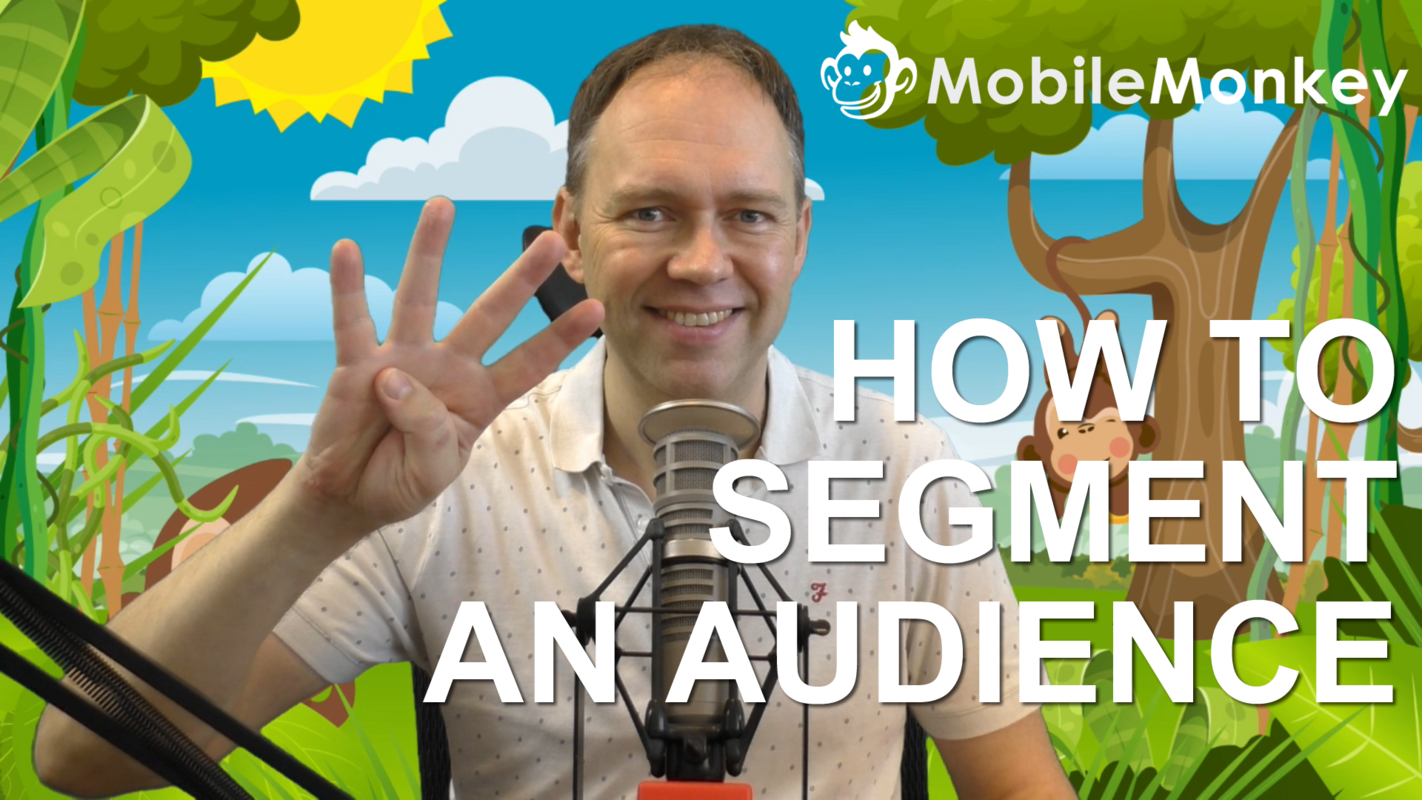This time last year, Larry Kim, Customers.ai CEO and a top-5 marketer in the world, made a jaw-dropping admission: Facebook Messenger banned his Page.
Long story short, Larry wasn’t segmenting the audience receiving his Facebook Messenger updates. So people were receiving irrelevant messages and reporting his Page as spam.
Facebook responded with the ban-hammer.
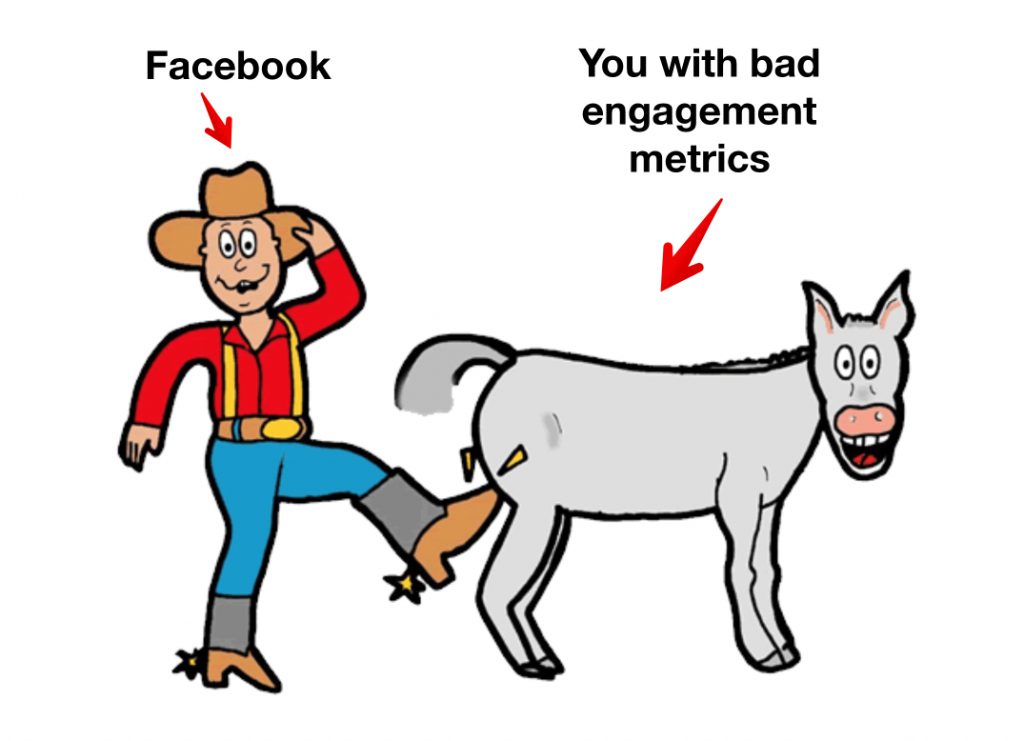
Larry’s story is a worst-case-scenario of what can happen when marketers overlook audience segmentation and customer experience personalization. Audiences respond to segmentation gaffes with lower engagement and depressed marketing ROI.
On the flip side, audience segmentation can be the key to 3X better marketing engagement, open rates, reach and conversions.
In this article we’re going to cover how to segment an audience and essential ways to do audience segmentation in actionable detail.
We’ll start with the basics like what and why, do a step-by-step how-to, and end with 5 advanced tips for how to do audience segmentation you may be missing.
We include a case study showing how audience segmentation leads to higher return on your marketing investment.
How to Segment an Audience Table of Contents
- What is audience segmentation?
- What does it mean to segment an audience?
- What is the purpose of audience segmentation?
- Step-by-step process for marketers: How to do audience segmentation
- What are some common ways to segment an audience?
- Game-changer: Why you no longer have to make assumptions about who your audience are
- How to segment an audience inside Customers.ai
- Customers.ai audience segmentation case study
- 5 advanced segmentation hacks you can do in Customers.ai to increase engagement
What is audience segmentation?
Audience segmentation means using customer data to create meaningful audience segments. The objective of audience segmentation is to deliver marketing messaging that are relevant to the person reading it.
For example:
- Maternity wear is marketed to an audience of pregnant women. The audience can be further segmented into trimester of pregnancy or region where they live so that clothing promotions match what they want to buy now.
- Lawn care services are marketed to home owners. Creating segments based on location will help match messaging to local service providers, and help the business offer location-specific or relevant seasonal services.
- Accounting software may be designed for business owners. The audience could be segmented by size of company or industry so that marketing messages reflect the solutions and advantages that help the individual reader.
What does it mean to segment an audience?
When a business segments an audience, they use customer data to divide a larger audience into smaller groups with things in common in order to personalize the messaging and offers. Rudimentary data masking used to protect the privacy of your customers can destroy the details of your data. Synthetic data generation can give you both privacy and granular level insights on segments.
Marketing and advertising platforms like Customers.ai, Facebook Ads, Google Ads, HubSpot, MailChimp and others, are used by marketers to filter audiences based on segmentation criteria.
For example, a nutritional supplements company may segment it’s large customer database of athletes into defined audience segments based on:
- Their sport or activity
- Their age
- Their income
- Their history of purchasing vitamins and supplements
- Their indicated preference for certain ingredients or preparations
- Their past interactions with the company
Segmenting an audience allows marketers to tailor messages to who the customer is to speak to solutions they want and need.
Join Today’s Webinar with Larry Kim!
Or Register for the Free Replay
Learn all about NEW 100% Meta-Approved Automation Tools from Customers.ai with a spotlight on features to 10X Instagram & Facebook Engagement and turn social media into a revenue driver for your business.

What is the purpose of audience segmentation?
The purpose of audience segmentation is to divide the larger audience into groups with common interests so that marketing campaigns reach and resonate with the target audience segment.
The more a business can speak to the personal needs of their prospect or customer, the more effective their marketing and customer communication will be.
In turn, the more effective their marketing, the more products or services the business can sell.
Notably, marketers usually have more than one type of customer they want to address.
Typically each type of customer has its own motivations, needs, and lingo. Often, some audience segments won’t identify with the same messages, benefits and channels that resonate with others.
Why do audience segmentation?
Audience segmentation results marketing campaigns with better engagement and more loyal customers. Audience segmentation generates leads more effectively than non-targeted messaging.
By knowing their customers, marketers can send messages and promotions that address the unique needs of their various customer segments. This leads to higher brand affinity and engagement.
And businesses can focus on marketing to audience segments that are most likely to purchase or can be expected to generate higher average order values.
How to do audience segmentation: Step-by-step process for marketers

Here’s the process break-down of how to segment an audience:
- Step 1: Define your target customer personas.
- Step 2: Identify criteria that differentiate personas.
- Step 3: Analyze the available customer data. Collect additional data as needed using surveys or customer feedback.
- Step 4: Ensure the customer data used as segmentation criteria is available in the platform you will use to send messages.
- Step 5: Segment the audience using the chosen criteria.
Now you’re ready to create campaigns targeted to your audience segment.
What are some common ways to segment an audience?
There are many types of audience segmentation in digital marketing.
Common ways to segment an audience include segments based on criteria like:
- Demographics – age, race, location, gender, language
- Behaviors – such as job, purchase behavior, search behavior
- Interests – likes, pursuits, fandom
- Psychographics – personality, values, opinions, attitudes, and lifestyle
- Audience size – large, small, broad, narrow

How to segment an audience using Facebook user data
Personalization has become a very important trend in marketing for the last few years and technology is making that more and more accessible for marketers in the everyday with the platforms that they’re already using.
We got really used to segmentation in and the ability to hyper-target our customers using advertising platforms like Facebook.
Facebook Ads Manager offers incredibly detailed demographic and psychographic audience targeting from interests and behaviors to job titles and locations.
Now with all of our marketing automation platforms, we can create awesome audience segments that help boost our performance because we’re speaking more directly to the user persona or even the user themselves.
Personalization can be as simple as messaging a user with their first name. This allows us to greet them with a lot of familiarity. Even basic personalization like using a first name can help a message stand out in a sea of messaging.
Take it a step further and start asking the audience questions to get to know who they are. This is especially easy using website chatbots and click-to-Messenger ads with automated message sales funnels.
The importance of using our contact segmentation tools can’t be underestimated in modern marketing, as higher engagement rates result it higher organic reach and higher conversion rates.
Game-changer: Why you no longer have to make assumptions about who your audience are
You no longer have to make assumptions about who your audience are, making guesses about who your user is and how they got there. This is especially prevalent with traditional landing pages versus clean landing pages.
With chatbots, we can ask our users questions directly. And we can engage with them and serve them exactly the kind of tailored content they need. This helps help them in their journey, solving some of the problems that they’re facing.
The more we find out about our users, the more we’re able to discover the sort of content that they’re really interested in, content that would enrich their lives.
Chatbots enable you to converse in a story-like manner with your audience, and if it’s done right, your user feels like the story has been crafted personally for them.
How to segment an audience by building audience segmentation categories through a chatbot
When people start talking to the Customers.ai chatbot, they will immediately be asked the question, “can we chat with you today?” This provides an opt-in conversation.
After we receive an affirmative response we might say: “We would love to show you all the ways that chatbots can help you. Would you like to start with the case studies, some business use cases or some hands-on tactics?”
Depending on the user’s place in the buyer’s journey and their background and experience, this will inform us what they’re looking to learn more about and how we can engage with them deeper.
What content are your users interested in?
If we know that they’re really interested in case studies for example (n.b. check out our chatbot marketing case studies), we tag that user as somebody who’s interested in case studies, and learn about their industry segment based upon the case studies that they’re viewing. This lets us build audience segmentation categories directly through the chatbot.
If the user asks for more information about business use cases for chatbots for example, we’re then able to tag them as somebody who’s in a certain industry for that particular use case. This methodology could be utilized just as easily with Facebook lead generation or for an eCommerce use case.
Enriching audiences with tags and attributes in addition to Facebook default contact info
We tag our users and we save all of these rich and growing user profiles to allow us to create some really valuable segments, allowing us to deliver follow-up content marketing that results in meaningful engagement.
It’s really simple to set up audience segmentations in Customers.ai in order to send follow-up messaging, whether it’s automated drip campaigns or one-off mass message blasts to those segments.
We also get a lot of default information about users automatically if we’re talking about chatbots in the Facebook system.
For example, when somebody messages your Facebook page, Facebook automatically gives the business information including first and last name as well as their location, gender and profile photo.
You can make some educated assumptions about who people are based on the default data that Facebook provides. This provides a great starting point to your own audience segmentation efforts.
How to Segment an Audience Using Customers.ai Chat Marketing Tools
Let’s take a look at how easy it is to segment an audience inside Customers.ai…
This is a game-changer when you want it to send really specific content, just the right users. Click here to demo the bot we build together in the following step-by-step audience segmentation tutorial.
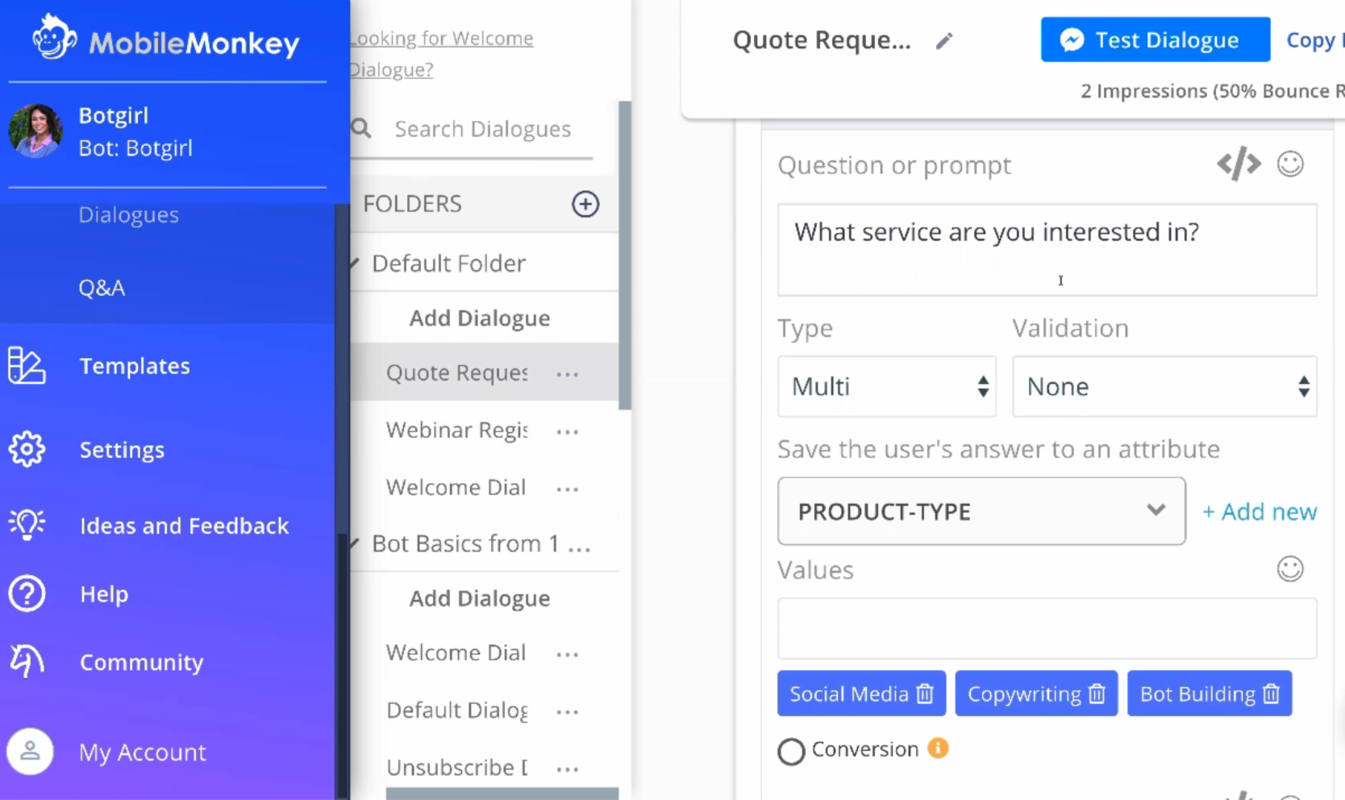
How to establish the service that’s the best fit for each user
In the screenshot above we take a look at the example of a conversation where we’re going to ask people what service they’re really interested in. (This is in the Advanced Bot Builder section of Customers.ai).
In this particular dialogue, we ask people: “what service are you interested in?” We’re giving the user 3 options here: “social media”, “copywriting” or “bot building”. And we save their response to their customer profile.
Let’s create an audience just of the social media group. In order to create the audience segment of people who have responded that they’re interested in social media services, we create a new audience.
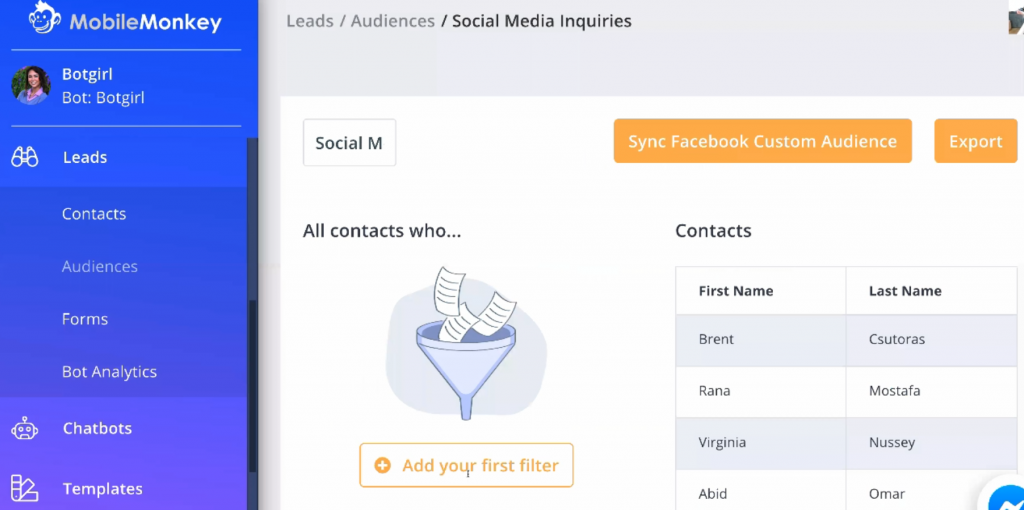
Let’s name this audience “Social Media Inquiries”. We’ll go ahead and add a filter of people who have responded to that product type as “social media”.

Quickly, we’ve been able to apply three different kinds of filters to our audience and it’s just as easy for you to do something similar.
The difference between attributes and tags
Note: If you ask a question that has multiple answers, then you would apply an “attribute” to each answer. In our example we said: “what service are you interested in?” “Social media”, “copywriting” or “bot building?”
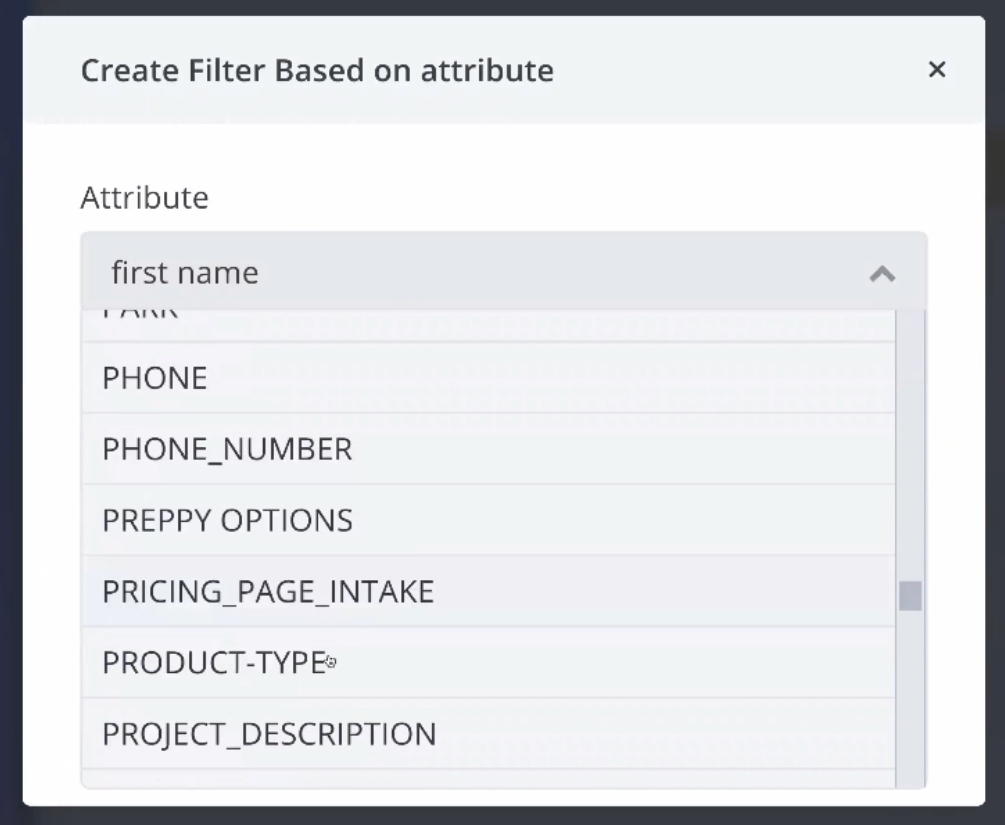
We’re going to be applying an attribute to each of those three values, saved to the user profile.
A tag would be used if there’s only one option. For example, if someone clicks on a button or a link, then you can apply a tag.
Applying the attribute filter to create an audience segment
In this example we’re going to hit the “attribute filter” and we’re going to have a drop-down menu of options where we can select the attribute type that we’re going to use.
We know this one is called “product type”. We select “product type” from our drop-down menu and then you have further options such as “equals”, or “does not equal”. In this instance, we know that we want “equals”.
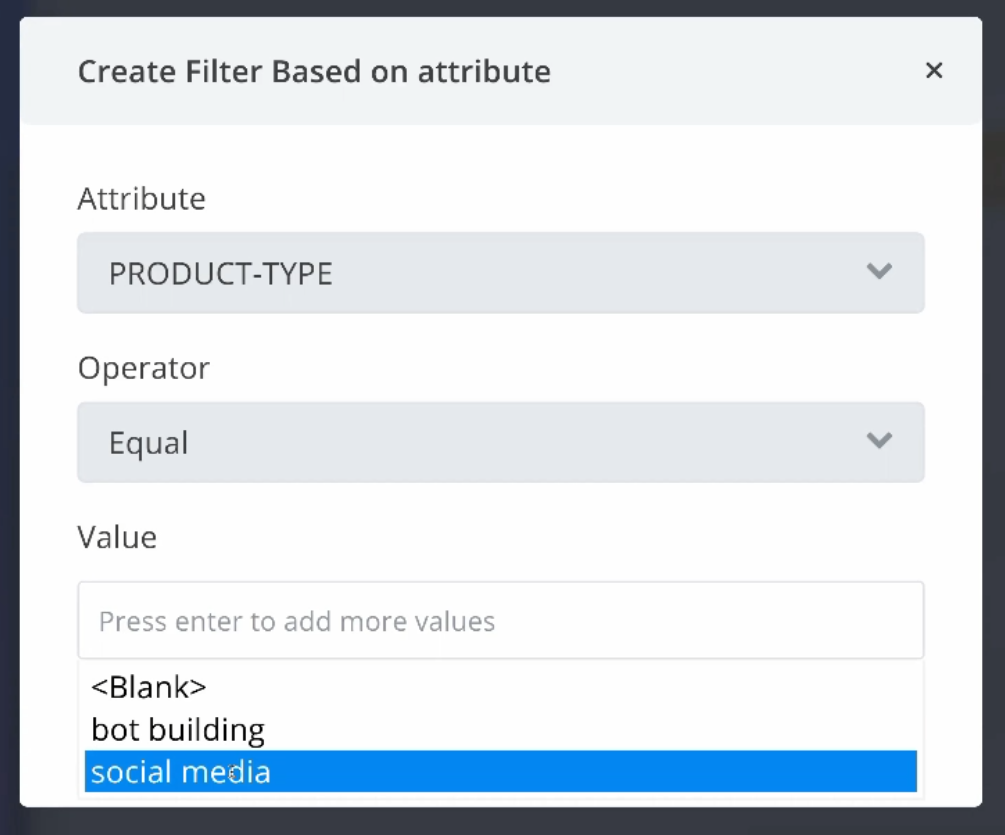
We can see in the above screenshot that people have only answered “social media” and “bot building” when they’ve responded to this question because in the dropdown it’ll give us the options that our audience have selected.
Let’s create this “social media” audience and save it.

That’s how easy it is to create an audience segment based on any of the information that we have on our users, whether we’ve received this as a default from having that initial conversation through Facebook; or through the conversations and questions that we’ve asked of contacts as follow-ups.
Demo this audience segmentation bot
What to test out the bot we just reviewed and created? Check it out! Click here to see our bot in action.
Customers.ai Audience Segmentation Case Study & Key Insight to Increase Engagement
Let’s go back to Larry Kim’s story. Remember, he was sending subscription Facebook messages to all subscribers.
However, those messages weren’t getting the greatest engagement metrics, and was the reason Larry’s bot got blocked by a lot of people!
Performance was really falling by sending Messenger marketing campaigns to the full contact list.
A simple list segmentation made all the difference. Compare the stats of message engagement to a campaign sent to an audience of All Contacts vs. an audience of only English speaking contacts:
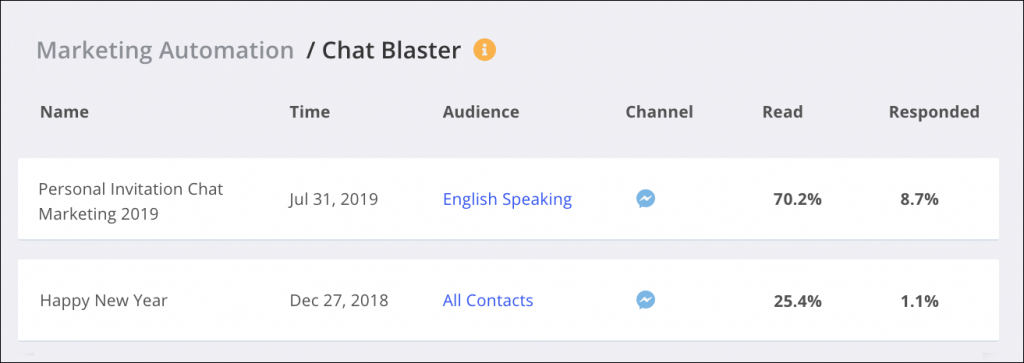
Open rate nearly tripled as a result of audience segmentation. Response rate (people interacting with the message by clicking and replying to the bot) jumped up too!
Key segmentation insight: Segment your audience so you don’t annoy users and you don’t annoy Facebook
One of the segments that you can easily create using default information from Facebook is to segment your audience based upon the language that’s spoken.
Larry found by adding a simple segmentation for people who spoke English, because his messages were written in English, it instantly improved our engagement and lowered the block rate because the audience was receiving the message in their native language.
This demonstrates the power of segmentation using one of the simple, out-of-the-box filters that Facebook provides.
The more segmentation you do, the more confident you can be that the message you’re sending is going to be appropriate and likely to resonate with whoever’s receiving your messages.
The last thing that you want to do is send loads of messages to an audience that is just not in the mood or just not right for that particular message. It’s the quickest way to annoy audience!
Also, you want to keep your reputation as good as possible with Facebook, meaning that Facebook is confident that your audience want to hear from you.
Don’t go overboard with audience segmenting
However, with so many options on the table, you shouldn’t segment just for the sake of it.
Only segment as much as it makes sense for your business as well as who your audience is.
You can segment all day long, but you have to think also about the best use of your time and the best value for your business.
Focus on your obvious audience segmentation wins first
There are certain things that you can figure out that are real obvious wins such as the ones that we’ve already hit upon in this article.
I’m sure that, as you learn more about who your users are, you’ll be able to create these larger buckets and personas that align with the content that you’re making.
This will be a good fit for balancing between the value to the business and the time it takes to create your segments and content.
Don’t spend too much time on this. Look at the areas in your business that are likely to result in the most positive financial impact as a result of that segmentation.
Test segmentation, especially when it comes to paid traffic
A friend of ours at here at Customers.ai, Isaac Rudansky, put together one of our first chatbot marketing courses.
While he was doing so, he did some tests around segmenting by gender and matching ad creative and offers. They found that audience segmentation was really effective.
If you’re putting some ad spend behind a campaign, you’re going to be able to create test environments and you’ll want to see which campaigns are performing better.
Isaac found data that supported the fact that that segmenting by gender and then speaking in language that really reflected the target gender was a big performance booster.
Use your time wisely but test when it’s appropriate to do so. You might be surprised in the importance of audience segmentation to your future business growth!
5 Advanced Hacks for How to Segment an Audience You Can Do Using Customers.ai
Advanced audience segmentation tip #1: Tag your audience based upon their actions
Tag your audience based upon their actions, allowing you to deliver them more targeted messaging in the future, as well as knowing when not to send them messages.
This is especially useful when utilizing Customers.ai’s OmniChat, allowing you to send campaigns to audience segments that cross messaging platforms.
(E.g. a drip campaign to Facebook Messenger AND SMS contacts that meet the criteria of brand new contact.)
This doubles the value of your segmentation efforts and saves you time building campaigns.
Advanced audience segmentation tip #2: Ask your audience to self-select what they’re interested in
An attribute is like a self-selected category that your users belong to.
Building attribute segments can help you identify what products your audience members are interested in and who’s ready to buy right now.
Advanced audience segmentation tip #3: Make use of the default data that Facebook provides you with
Don’t forget to make sure of the default user data that Facebook automatically supplies you with in your segmentation – remember the example that we shared on how to improve engagement by ensuring that the messaging you send is in the language that your user prefers.
Advanced audience segmentation tip #4: Split-test segments
Remember that not all segments are obvious.
Our last example showed that you may improve your engagement and conversion rates by tailoring your message to a male or female audience.
Make sure that you continually run split-tests to your audience segments, whether in your click-to-Messenger ads, Sponsored Message ads or SMS and Facebook Messenger chat blasts. The results may surprise you.
Advanced audience segmentation tip #5: Only segment when it makes sense for you
Don’t segment unless it makes sense for your business and resources.
Segmentation requires effort and resources. It takes time to properly segment audiences, staff time to create separate messages and creative, and budget to spend on additional channels. Often, resources won’t allow for infinite audience segments so it’s important to identify the most valuable audience segment to focus on.
Segment your audience based upon your products and your services and increasing your ability to encourage users to engage with what you do and the content that you produce.
We hope that you enjoyed this episode of the Chat Marketing Train! How are you currently segmenting your audience? What unexpected audience segmentation criteria resulted in remarkable lift in your marketing KPIs?
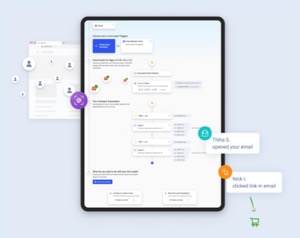
See Who Is On Your Site Right Now!
Get names, emails, phone numbers & more.
Try it Free, No Credit Card Required
How to Segment an Audience: Important Next Steps
Audience Segmentation FAQs
What is audience segmentation?
Audience segmentation is the process of dividing a larger audience into smaller, more specific groups based on characteristics like demographics, behaviors, interests, or purchasing habits. This allows marketers to create targeted campaigns that resonate with each segment, increasing the relevance and effectiveness of their marketing efforts.
Why is audience segmentation important?
Audience segmentation is essential for delivering personalized, relevant messages that appeal to different groups within a larger audience. It improves engagement rates, conversion, and customer satisfaction by tailoring messages to specific needs, making your marketing more efficient and cost-effective.
What are the main types of audience segmentation?
The four main types are:
- Demographic Segmentation: Based on characteristics like age, gender, and income.
- Geographic Segmentation: Targets based on location, such as city or climate.
- Behavioral Segmentation: Groups based on actions, like purchase history or usage rate.
- Psychographic Segmentation: Considers lifestyle, values, and personality traits.
How do I start segmenting my audience?
Start by analyzing your data to identify patterns. Common steps include:
- Collecting Customer Data: Gather demographic, behavioral, and purchase data.
- Defining Key Segments: Based on your marketing goals, create segments.
- Testing and Refining: Use initial campaigns to refine segments based on results.
- What data should I use for audience segmentation?
- Useful data includes demographic information, past purchases, website behavior, engagement rates, and survey responses. Combining these data types allows for richer, more actionable segments.
Can you give an example of demographic segmentation?
Demographic segmentation might include targeting young adults aged 18-24 with products geared towards college students, while promoting retirement services to individuals aged 55 and older.
What is behavioral segmentation, and how is it used?
Behavioral segmentation groups audiences based on actions, such as browsing habits, purchase frequency, or brand loyalty. For example, a travel company might target “frequent travelers” with loyalty rewards, while promoting introductory packages to “first-time travelers.”
How does geographic segmentation work?
Geographic segmentation targets customers based on location, which can range from country to city or even neighborhood level. It’s useful for businesses like restaurants or retailers that want to promote local deals or events, or brands targeting specific climates with season-appropriate products.
What are psychographics, and why are they useful for segmentation?
Psychographics delve into personality, values, interests, and lifestyles. This approach is particularly valuable for brands wanting to align their message with customer values, like promoting eco-friendly products to environmentally conscious consumers.
How can audience segmentation improve email marketing?
Segmentation allows marketers to send tailored emails to different groups, increasing open rates, click-through rates, and engagement. For example, a clothing retailer might send emails about winter jackets to customers in colder regions, while promoting swimwear to those in warmer climates.
What tools can help with audience segmentation?
Tools like Google Analytics, CRM software (e.g., HubSpot, Salesforce), and email marketing platforms (e.g., Mailchimp, ActiveCampaign) help collect and analyze data for segmentation, enabling automated, targeted messaging.
How does segmentation affect ad targeting?
Segmentation allows for more precise ad targeting. By segmenting audiences, advertisers can create specific ad sets that appeal to each group’s needs, such as promoting luxury products to high-income individuals or featuring budget-friendly items to price-sensitive segments.
What is the difference between segmentation and targeting?
Segmentation is the process of dividing a broad audience into smaller groups, while targeting involves selecting specific segments to focus on with tailored marketing messages. Segmentation is about understanding your audience, and targeting is about choosing where to direct resources.
Can small businesses benefit from audience segmentation?
Yes, small businesses can benefit greatly. Segmentation allows small businesses to compete with larger ones by delivering highly relevant messages to niche audiences, which can lead to more efficient marketing spend and stronger customer loyalty.
How do you measure the success of audience segmentation?
Success can be measured by comparing engagement, conversion rates, and ROI across segments. Metrics like click-through rates for emails, ad engagement, and sales conversion rates provide insights into whether segmentation improves performance.
What are common mistakes in audience segmentation?
Common mistakes include over-segmenting, which can dilute your message, relying on assumptions rather than data, and failing to update segments as customer preferences evolve. Each of these can lead to ineffective marketing efforts.
How often should you update your audience segments?
Updating segments depends on your industry and audience behaviors, but reviewing segments every 6-12 months is recommended. For highly dynamic markets, like fashion or tech, more frequent updates are necessary to keep up with changing trends.
What is lifestyle segmentation, and when is it useful?
Lifestyle segmentation is a form of psychographic segmentation that groups people based on hobbies, spending habits, and social behaviors. This is useful for brands like fitness companies or travel agencies that want to target individuals whose lifestyles align with their offerings.
How can segmentation improve customer retention?
Segmentation enables tailored communication with current customers based on purchase history and preferences. For example, offering loyalty rewards to repeat customers or recommending new products similar to past purchases can enhance customer satisfaction and retention.
What’s the role of personalization in audience segmentation?
Personalization is the outcome of effective segmentation. When you segment your audience accurately, you can craft messages that speak directly to individual needs and preferences, increasing engagement and creating a sense of connection.
What is occasion-based segmentation?
Occasion-based segmentation groups customers based on specific times or events, like holidays or life milestones. Retailers use this to target customers during the holiday season or to send birthday promotions, tailoring offers based on specific occasions.
How can segmentation improve content marketing?
Segmentation in content marketing means creating tailored content for each audience group. For instance, a tech company could produce in-depth whitepapers for enterprise clients while offering quick tips or blog posts for small business owners.
What’s an example of using purchase behavior for segmentation?
A skincare brand might segment customers into groups based on purchase frequency—such as “one-time buyers” versus “repeat customers.” They could send loyalty discounts to repeat customers while offering introductory deals to one-time buyers to encourage future purchases.
How does segmentation impact social media marketing?
Segmentation helps target content on social media platforms to appeal to different audience interests. For example, a food brand might post recipes for health-conscious followers while promoting convenience meals to busy professionals, aligning content with audience preferences.
What are lookalike audiences, and how do they relate to segmentation?
Lookalike audiences are groups of people who share similar traits with your existing customer segments. They are useful for expanding reach by targeting individuals who are likely to be interested in your products or services based on similarities to your best customers.
